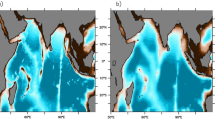Abstract
An ocean general circulation model of global domain, full continental geometry and bottom topography, is used to study the influence of the Bering Strait on the general circulation by comparing equilibrium solutions obtained with and without a land-bridge between Siberia and Alaska. The model is integrated with restoring boundary conditions (BC) on temperature and salinity, and later, with mixed BC in which a restoring BC on temperature is maintained but a specified flux condition on salinity is imposed. In both cases, the effect of the Bering Strait is to allow a flow of about 1.25–1.5 Sv from the North Pacific to the Arctic Ocean and, ultimately, back to the North Pacific along the western boundary current regions of the Atlantic and Indian Oceans. When a restoring BC on salinity is used, the overturning associated with North Atlantic Deep Water and Antarctic Intermediate Water formation are increased if the Bering Strait is present in the model geometry. The result of switching to a specified flux BC on salinity is to cause a transition in the THC in which the overturning associated with North Atlantic Deep Water formation increases from about 12 Sv to about 22 Sv. This transition occurs in an essentially smooth fashion with no significant variability and is about 12% smaller in magnitude if the Bering Strait is present in the model geometry. Because the Bering Strait appears to exert some influence on the general circulation and the formation of deep water masses, it is recommended that this Strait be included in the geometry of similar resolution models designed to study the deep ocean and potential changes in climate.
Similar content being viewed by others
References
Broecker WS (1987) Unpleasant surprises in the greenhouse? Nature 328:123–126
Broecker WS (1991) The great ocean conveyor. Oceanography 4:79–89
Broecker WS, Peteet D, Rind D (1985) Does the ocean-atmosphere have more than one stable mode of operation? Nature 315:21–25
Bryan F (1986) High-latitude salinity effects and interhemispheric thermohaline circulation. Nature 323:301–304
Bryan F (1987) Parameter sensitivity of primitive equation ocean general circulation models. J Phys Oceanogr 17:970–985
Bryan K (1969) A numerical method for the study of the circulation of the world ocean. J Comput Phys 4:347–376
Coachman LK, Aagaard K (1981) Re-evaluation of water transports in the vicinity of Bering Strait. In Hood DW, Calder JA (eds) The Eastern Bering Sea Shelf: oceanography and resources, volume 1. University of Washington Press, Seattle, pp 95–110
Coachman LK, Aagaard K (1988) Transports through Bering Strait: annual and interannual variability. J Geophys Res 93:15535–15539
Gordon AL (1986) Inter-ocean exchange of thermocline water. J Geophys Res 91:5037–5050
Hall MM, Bryden HL (1982) Direct estimates and mechnisms of ocean heat transport. Deep-Sea Res 29:339–359
Hellerman S, Rosenstein M (1983) Normal monthly windstress over the world ocean with error estimates. J Phys Oceanogr 13:1093–1104
Levitus S (1982) Climatological atlas of the world ocean. Nat Ocean Atmos Adm. Professional Paper 13, US Government Printing Office, Washington DC
Manabe S, Stouffer RJ (1988) Two stable equilibria of a coupled ocean-atmosphere model. J Clim 1:841–866
Marotzke J, Willebrand J (1991) Multiple equilibria of the global thermohaline circulation. J Phys Oceanogr 21:1372–1385
Moore AM, Reason CJC (1993) The response of a global ocean general circulation model to climatological surface boundary conditions for temperature and salinity. J Phys Oceanogr 23:300–328
Pacanowski RC, Dixon K, Rosati A (1991) The GFDL modular ocean model users guide, version 1.0. GFDL Ocean Group Technical Report No. 2 Princeton University
Power SB, R Kleeman (1993) Multiple equilibria in a global ocean general circulation model. J Phys Oceanogr 23:1670–1681
Warren BA (1983) Why is no deep water formed in the Pacific Ocean? J Mar Res 41:327–347
Weaver AJ, Sarachik ES (1991a) Evidence for decadal variability in an ocean general circulation model. Atmos Ocean 29:197–231
Weaver AJ, Sarachik ES (1991b) The role of mixed boundary conditions in numerical models of the ocean's climate. J Phys Oceanogr 21:1470–1493
Weaver AJ, Sarachik ES, Marotzke J (1991) Freshwater flux forcing of decadal and inter-decadal oceanic variability. Nature 353:836–838
Weaver AJ, Marotzke, J, Cummins PF, Sarachik ES (1993) Stability and variability of the thermohaline circulation. J Phys Oceanogr 23:39–60
Wijffels SE, Schmitt RW, Bryden HL, Stigebrandt A (1992) Transport of freshwater by the oceans. J Phys Oceanogr 22:155–162
Author information
Authors and Affiliations
Additional information
Correspondence to: CJC Reason
Rights and permissions
About this article
Cite this article
Reason, C.J.C., Power, S.B. The influence of the Bering Strait on the circulation in a coarse resolution global ocean model. Climate Dynamics 9, 363–369 (1994). https://doi.org/10.1007/BF00223448
Received:
Accepted:
Issue Date:
DOI: https://doi.org/10.1007/BF00223448




